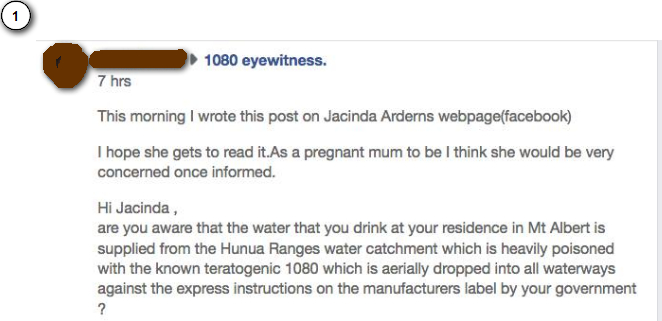Today a science-minded friend posted a screenshot of a post by another individual to the FB group 1080 eyewitness. Because it is a) heavy on the innuendo, b) inaccurate, and c) decidedly unpleasant, I thought it worthy of a bit of additional attention.
Let’s look at c) first. The original poster claimed to have written this on the Prime Minister’s FB page; it’s a particularly nasty attempt to sow fear & confusion in womens’ minds by using a combination of overstatement, innuendo, & downright inaccuracy. Jacinda Ardern is level-headed enough to ignore the item as an ill-founded rant, but I see no reason why someone should attempt to frighten others in order to push their own point of view in this way.

and, a little later

That is really is nasty.
Now b) – he implies that 1080 is a teratogen of the same order as thalidomide,

which doesn’t appear to be borne out by actual scientific evidence. For example, Eason et al. (1999) state that
1080 causes developmental defects in rats when pregnant females are exposed to relatively high doses (0.33 and 0.75 mg kg(-1) day(-1)) on a daily basis during the period of organogenesis (from days 6 through to 17 of gestation). The developmental abnormalities observed were mild skeletal effects: slightly curved forelimbs, and bent or “wavy” ribs. [The birth defects caused by thalidomide are much more severe.]
These concentrations are quite high. They are also much higher than the precautionary drinking water standard defined by the Ministry of Health (2 parts per billion), and much higher than has ever been detected in water flowing from watersheds where 1080 has been dropped (0.1 parts per billion). In addition, NIWA comments that
Importantly, no 1080 has been detected in drinking water supplies.
Similarly, in 2011 Eason & his colleagues pointed out that (my emphasis)
Results of the initial research and subsequent monitoring demonstrated that there has been no evidence of 1080 presence in reticulated water and no evidence of significant or prolonged 1080 contamination in surface waters
Brown also implies that teratogens can cross the placental barrier but other chemicals can’t. This is incorrect: plenty of chemicals cross the placenta. I mean, oxygen, anyone? Nutrients? But, more seriously, if ‘chemicals’ couldn’t cross the placenta then we wouldn’t see neonates affected by meth (P) or with foetal alcohol syndrome.
So, Brown is correct that 1080 is a teratogen. What he carefully ignores is that it has these effects at concentrations far higher than have ever been measured in our drinking water. That is, his implication that the PM, or anyone else drinking water supplied from the Hunua catchment, is “heavily poisoned” by 1080 is both incorrect, and blatant scaremongering.
Which pretty much addresses a) as well.
Now tea, on the other hand, does contain small but measureable quantities of sodium monofluoroacetate, aka 1080. I wonder what Brown’s take on that would be?
Please note: none of this should be taken to mean that 1080 is a benign substance. It’s not. But it is the best currently-available mechanism for controlling pest species in those parts of New Zealand where other methods fail. And as Eason et al. (2011) comment
There has been no evidence of significant or prolonged 1080 contamination of surface waters… The risks associated with 1080 to human health are determined by the toxicity of 1080 and the potential for exposure: risk = hazard × exposure. The innate toxicity of 1080 is not in question, as there are clearly identified lethal and sub-lethal effects as illustrated above. However, exposure risk to humans is very low with the exception of the small group of workers in the pest control industry, a group that has been closely monitored to try to ensure minimal exposure (Beasley et al. 2009).
Because of this, they state that
the use of 1080 must continue to include safeguards that focus on those individually handling 1080 or 1080 baits to ensure they do not ingest, inhale or absorb 1080.
C.T.Eason, M.Wickstrom, P.Turck & G.R.G.Wright (1999) A review of recent regulatory and environmental toxicology studies on 1080: Results and implications. New Zealand Journal of Ecology 23(2): 129-137
C.Eason, A.Miller, S.Ogilvie & A.Fairweather (2011) An updated review of the toxicology and ecotoxicology of sodium fluoroacetate (1080) in relation to its use as a pest control agent in New Zealand. New Zealand Journal of Ecology 35(1): 1-20